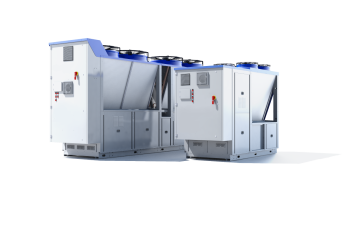F-Gas refrigerants
Fluorinated gases (F-gasses, F-gas) are man-made, greenhouse gases, that have been used as refrigerant in heating, ventilating, air conditioning and refrigeration (HVAC&R) systems since they were first developed in the late 1920s. The main fluorinated gasses include Chlorofluorocarbons (CFCs), Hydrochlorofluorocarbons (HCFCs), Hydrofluorocarbons (HFCs), Hydrofluoroolefins (HFOs) and refrigerant blends.
Fluorinated gasses and the environment
Refrigeration systems had long been in use before the development of F-gasses, with natural refrigerants taking the helm. However, the collaboration between earlier systems and natural refrigerants had its issues, with flammability, toxicity and the corrosive nature of some natural refrigerants causing big problems. Therefore, synthetic, F-gas refrigerants were engineered, with properties that not only solved some of the big issues with natural refrigerants but were also designed to suit different HVAC and refrigeration applications.
However, it was discovered that the benefits of synthetic refrigerants came at a cost to the environment. From contributing to the hole in the ozone layer, to playing a role in global warming, F-gasses have proven to be problematic. For decades we’ve been embroiled in a cycle of banning or phasing down use of the most harmful refrigerants, developing new F-gasses as replacements, and then banning those replacements, as regulations come into force restricting the use of the those with the highest Ozone Depletion Potential (ODP) and Global Warming Potential (GWP).
While regulations vary from country to country, the majority of nations are abiding to the timescales laid out in the Montreal Protocol (and its subsequent amendments), an international treaty regulating the production and consumption of Ozone Depleting Substances (ODS).
Types of F-gas
Chlorofluorocarbons (CFCs)
Chlorofluorocarbon contains chlorine (Cl), fluorine (F) and carbon (C). CFCs include refrigerants such as R-11, R-12, R-13, R-113, R-114 and R-115.
Invented to be ‘safe refrigerants,’ chlorofluorocarbons were widely used from the 1930s due to being non-toxic, non-flammable and very stable. However, unbeknown at the time, CFCs had a high Ozone Depletion Potential (ODP) and were playing a large role in the destruction of the ozone layer. Once this was discovered, moves were made to ban their use.
The Montreal Protocol sealed the fate of CFCs on 16 September 1987, with a gradual phase out. CFCs were banned in developed countries by 2000 and developing countries by 2010.
Hydrochlorofluorocarbons (HCFCs)
Hydrochlorofluorocarbon contains hydrogen (H), chlorine (Cl), fluorine (F) and carbon (C). HCFC’s include gases such as R-22, R-123, R-124 and R-142B.
HCFCs Like CFCs, were in wide use by the 1930s, having been developed to be ‘safe refrigerants,’ due to being non-toxic, non-flammable and very stable. However, it became apparent that HCFCs had a high Ozone Depletion Potential (ODP) also.
A later amendment to the Montreal Protocol extended the ban to HCFC’s, with a gradual phase out in developed countries by 2020 and by 2030 in the developing world.
Hydrofluorocarbons (HFCs)
Hydrofluorocarbons are created with hydrogen (H), fluorine (F) and carbon (C). HFC refrigerants include R-32, R-125, R-134A, R-143A, R-152A and R-410A.
HFCs were developed to take the place of CFCs and HCFCs, with an emphasis on Global Warming Potential (GWP). GWP measures potential as a greenhouse gas by comparing it to Carbon Dioxide (CO2). For example, the HFC R-23 has a GWP of 14,800, meaning that every kg of R-23 released into the atmosphere had the same greenhouse effect as 14,800 kg of CO2.
HFCs became widely used in the 1980’s with the introduction of the Montreal Protocol. While HFCs do not harm the ozone layer (they have an ODP of zero), they do have a high GWP. Just like CFCs and HCFCs, the fate of HFCs was sealed by the Kigali Amendment to the Montreal Protocol in October 2016. Under the Montreal Protocol, developed countries committed to a gradual HFC phase down from 2019. In developing countries, a freeze on HFC consumption levels comes into force from 2024 (or 2028 for some nations), with the aim for an 80-85% reduction in HFCs by the late 2040s.
The use of HFCs is widespread with R-134A one of the most commonly used HFC refrigerants, especially in chiller systems. R-410A will be another familiar HFC refrigerant, as it was introduced as a replacement for R-22 in residential and commercial applications. It is used widely in heat pump and VRF systems.
Hydrofluoroolefin (HFO)
Hydrofluoroolefins are created from hydrogen (H), fluorine (F) and carbon. HFOs are olefins (O), otherwise known as alkenes. Refrigerants include R-1234ze, R-1234yf and R-513A.
Following the discovery that HFC’s were also bad for the environment, HFOs were developed as the next generation of refrigerants. Hydrofluoroolefins are unsaturated organic compounds and have zero ODP and low GWP. Most HFOs are non-toxic and are either mildly flammable or non-flammable.
Additionally, some of the newly created HFO refrigerants such as R-513A offer a virtually identical performance to R-134A. However, not all HFOs offer this level of energy efficiency.
Refrigerant blends
As the name implies, refrigerant blends are made by mixing two or more different single component refrigerants. Refrigerant blends include the zeotropic blends (400 series), R-407C, R-448A, R-454A, R-454B, and the azeotropic blends R-500, R-502 and R-511A.
Refrigerant blends have been developed to replace high ODP and GWP refrigerants, and combat issues such as toxicity, flammability and corrosion. Refrigerant blends are classified as azeotropic or zeotropic. Azeotropic blends are created from refrigerants with a common boiling point, that do not separate under normal conditions and act as a single fluid. Zeotropic blends are created from refrigerants with different boiling points and will separate under normal conditions (as the component refrigerants act at different pressure).
While blends can be engineered to exacting specifications by manufacturers, they can have properties that differ from the original refrigerants they are replacing. Indeed, even those that seem an ideal match, may not act the same under all conditions.
Impact of F-gas regulations
HVAC&R manufactures are constantly developing new systems that can use the very latest climate friendly low GWP refrigerants. While this is great news for those seeking a new system, there will be challenges for those hoping to keep existing systems operational with banned, or soon to be banned refrigerants.
Whether you operate in Europe, Asia or Australia, new regulations controlling F-gases will change the air conditioning and refrigeration landscape over the years to come. Not every system will have an alternative compatible HFO, refrigerant blend or natural refrigerant to use. And for those that do, it’s unlikely it will be a straight swap, as works will be required to the system to make the switch.
Keeping systems running on old refrigerants will become increasingly expensive. As the HFC phase down progresses, the demand for dwindling supplies will rise. For many, taking the plunge and purchasing new HVAC&R plant will be a better option. New systems are a big investment, so it makes financial sense to install products that offer energy efficient, climate friendly refrigerant options, to future proof systems against ever changing regulations, and keep running costs as low as possible.
The best ways to choose such products is to look for those that have been certified. Certification programmes such as Eurovent Certified Performance not only guarantee the performance of products, but enable you to compare energy efficient products objectively, to make an informed decision. Certification means you don’t have to take manufacturer claims at face value. It enables you to choose a product whose performance has been verified by an impartial, independent and competent body.
Our easy to use search facility lets you view products by family, type, brand, model name and certificate number.
Search for certified products now





